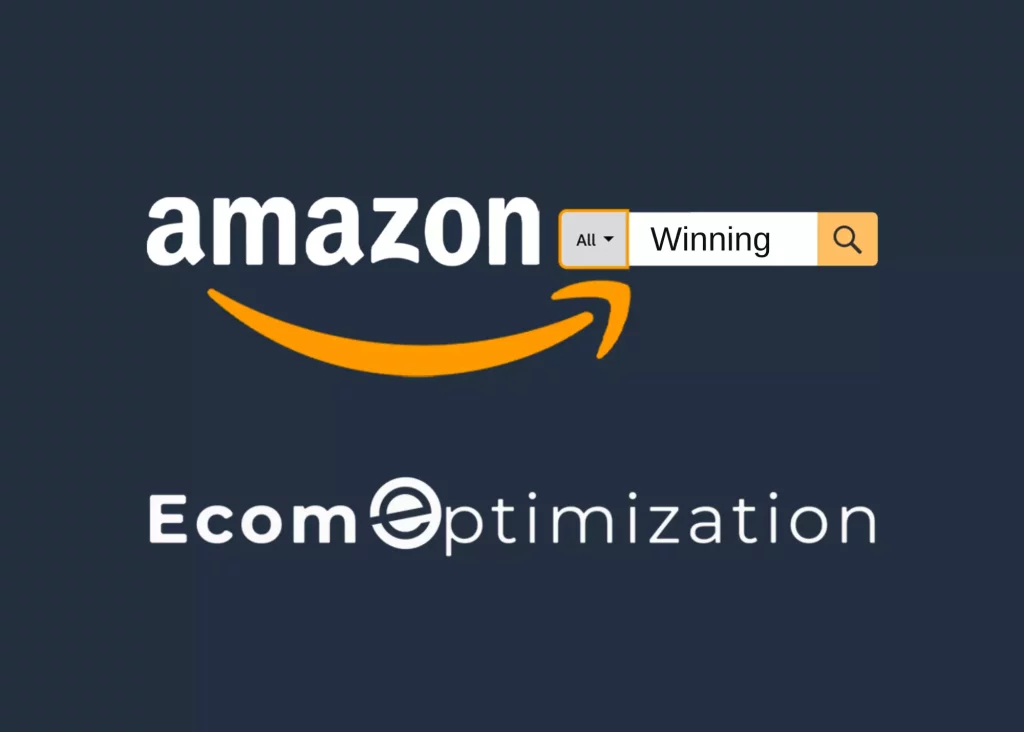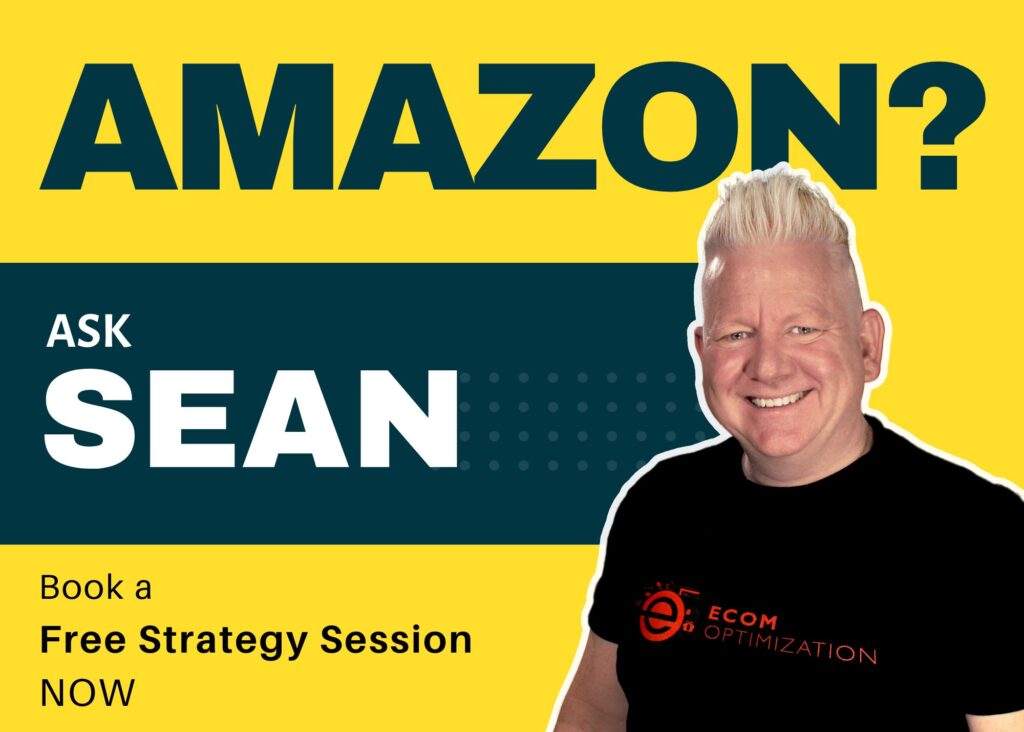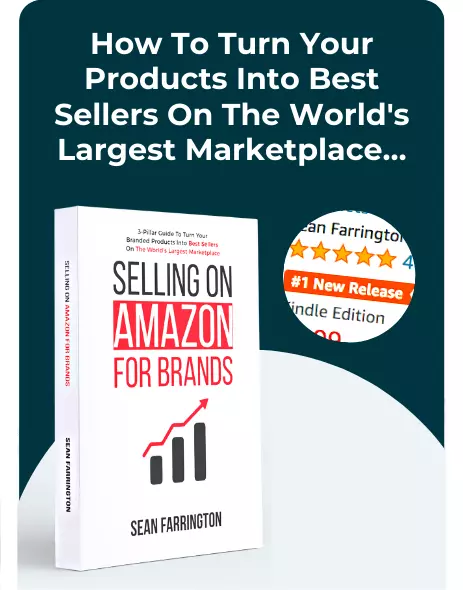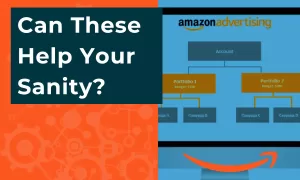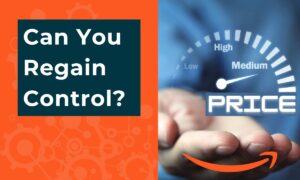Selling On Amazon 2024: Beginner’s Step-By-Step Guide To Start Up Success

How do I create an Amazon seller account in 2024?
How do I list products on Amazon?
What are the fees?
How can I optimize my product listings?
What are the most effective Amazon marketing strategies?
What are the top mistakes to avoid when selling on Amazon in 2024?
Hi I’m Sean Farrington.I have nothing to sell you, so Let’s make this journey together!”
We’ll start by breaking down the 16 steps you need to take to become an Amazon seller, because sadly, the onboarding process can be a bit tricky.
Jump To Section
Understanding the Basics of Selling on Amazon
Setting up shop on Amazon involves becoming an Amazon seller, listing your products, and waiting for a customer to make a purchase. Sounds pretty straightforward, right? Well, let’s go into a bit more detail.
Step 1: Become an Amazon Seller
Getting started begins with registering an Amazon Seller account, which we’ll go over in detail. Then we’ll cover how to manage your inventory, pricing, and transactions. More on this in just a bit.
Step 2: List Your Products
Once your account is set up, I’ll show you how to start adding product listings. A product listing includes the product title, description, and images. Think of it as your product’s online storefront. The key here is to be detailed and clear about what your product is and why it’s worth buying. Then
Step 3: Marketing Your Products
Once your products are listed on Amazon, the next step is catching the attention of buyers. Marketing plays a crucial role here.
We will cover how to align Amazon’s platform with your business goals, your target customer, and your product . We’ll also cover advertising services that increase visibility. Amazon SEO which boosts your standing in search results. If you have your own brand, I’ll show you how leveraging Amazon Brand Registry can give you better control over your product listings and use specialized tools to enhance your marketing.
Step 4: Handling Purchases
When a customer makes a purchase, Amazon alerts you via email. The next step is getting the product to the customer, either through direct shipping or via Amazon’s FBA program (more on this later).
Next…
Step 4: Get Paid!
Amazon will deposit funds into your bank account every two weeks. Capitalizing on opportunities to boost visibility and drive more sales will maximize your profits. We’ll address optimization strategies in a subsequent section. Finally…
Step 5: Customer Service and Follow-Up
Last but not least, managing customer feedback and dealing with potential returns and exchanges are also part of the Amazon Selling experience. Nurturing these relationships can result in repeat customers and a solid reputation.
In the following sections, we’ll unpack each of these steps in more detail, along with some tips and strategies for successfully navigating challenges that might come up along the way.
What are the potential challenges of selling on Amazon in 2024?
As you embark on your journey to selling on Amazon in 2024, it’s important you’re aware of the challenges you might encounter. While selling on Amazon can be quite rewarding, like any business it comes with its share of hurdles.
Fierce Competition
Amazon is a bustling marketplace that grew by 128,655 new sellers in major markets in 2023 alone. So competition is steep.
Standing out from the crowd can be daunting, particularly for new sellers. But, don’t worry, I am going to give you some cutting-edge ways to beat the competition.
Now, unlike Ebay and Etsy,you can’t just jump on and start selling right away.
What are the requirements to start selling on Amazon?
To begin selling on Amazon in 2024, there are several prerequisites and requirements that you must meet:
- Business Information: This includes your legal business name, address, and contact information. Ensure to have this readily available.
- Email Address: Amazon will need a valid email address to communicate with you.
- Bank Account: You’ll need an internationally chargeable credit card with a valid billing address associated with your bank account.
- Phone Number: A direct phone number is mandatory, where Amazon can reach you during the registration process.
- Tax Identity: Know your tax identity information. For US citizens, this will be either a Social Security number, a VAT certificate, or the company’s Federal Tax ID number.
- State Sales Tax Numbers: If you’re required to collect sales tax, be ready with your state sales tax ID numbers.
Wondering why the rigorous ID verification? Blame it on the fraudsters wreaking havoc in the Amazon jungle.
These troublemakers are not only causing mischief. They are taking over accounts, controlling them, and redirecting money. They are also selling fake items that deceive buyers and damage the good reputation of honest sellers like you.
Oh, and let’s not forget the sabotage—their favorite pastime. They’re out there, manipulating listings, tweaking details, and sowing chaos for legit sellers.
And then THose were the basics up until last year when Amazon decided to dig deep to avoid becoming a digital battleground. So, in 2023, Amazon added a new crime-busting step: So, a face-to-face interview to ensure you’re not one of them.
Don’t worry. It’s not an intense interrogation by the FBI. It’s proof that you’re an honest member of the online community.
But, passing the verification does not necessarily mean that you’ll be able to sell your product on Amazon.
What products can I sell on Amazon?
With Amazon being one of the largest online marketplaces worldwide, it offers immense versatility in product categories for potential sellers. Millions of customers browse through these commodities daily, creating a vast market for a wide variety of goods.
But, what can you sell on Amazon? Here’s the exciting part—there are numerous options! Let’s dive into the prominent categories:
From electronics to handmade goods, Amazon’s platform can handle just about anything. However, it’s worth noting that certain categories require pre-approval from Amazon before you can begin selling. So, let’s break it down:
Electronics
Electronics are a top-performing category on Amazon. No category approval required.
Books
Even in this digital age, physical books still bring in considerable revenue. Good news, no category approval required.
Beauty Products
Beauty products are yet another popular category. However, due to safety concerns, this category often requires approval from Amazon.
Clothing and Accessories
Clothing and accessories can be a profitable venture too. Yet again, keep in mind that selling clothing items may require Amazon’s approval.
Home and Kitchen
Home and kitchen items are always in demand. The good news, for most products in this category, no category approval required.
But, what do you do if your product is restricted…
What is Involved in Amazon Category Approval for Restricted Products?
Getting approval for restricted products on Amazon involves a detailed process. Amazon has a set list of restricted product categories and before you can sell these products, Amazon requires additional information and several performance checks for the seller.
Category Approval Process:
- Product Requirements: You must confirm that each product complies with all applicable regulations and laws. In addition, every single item listed must match the item in Amazon’s product catalog exactly.
- Documentation: Depending on the category, Amazon may need you to provide product documentation like safety tests, Certificates of Analysis (must be issued within 180 days of application). Sometimes you may need to provide purchase invoices, CE markings. And often you will need to provide product photos. Please note they are looking for proof that your product is real, and the label and packaging match your product claims. So, take a picture with your phone on your desk. Have a hand in the photo so they know you are not submitting a 3D rendering
Once you’ve ensured all this, you can apply for category approval from your Seller Central.
But, there may be a delay.
Bear in mind that gaining approval to sell in restricted categories does not guarantee your products will not be removed from the website in the future. Amazon continues to monitor listings to ensure adherence to their guidelines and safety standards. Therefore, it’s crucial to always remain in compliance with the rules stipulated by Amazon.
Pro Tip:
- Always have digital copies of all important product documents.
- IDedicate significant time to understand and comply with Amazon’s regulations and laws.
- Act promptly and professionally if Amazon contacts you for additional information.
- Continuously monitor your listings for compliance.
While it’s true that Amazon opens its doors widely for potential sellers, it’s also crucial to note that there’s a cost for almost everything on this platform.
How much does it cost to start selling on Amazon?
Let’s break down these costs to make sure you’re well informed.
Amazon Seller Account Fee
Amazon provides two types of selling plans: Individual and Professional. The Individual selling plan costs $0.99 per item sold, perfect for sellers who plan to sell fewer than 40 items per month. On the other hand, the Professional selling plan comes at a flat rate of $39.99 per month, suitable for those intending to sell more than 40 items monthly.
Referral Fees
Amazon takes a portion of each sale, called the referral fee. This fee typically ranges from 6% to 45% of the sale price, depending on the category your item falls into. For most products, expect a fee of around 15%.
Variable Closing Fees
For media products like books, music, video games, software, and DVDs, Amazon also charges a variable closing fee. This cost can range from $1.35 to $1.80 per unit.
Fulfillment Fees
If you opt to use the Fulfillment by Amazon (FBA) service, Amazon handles storage, packing, shipping, customer service, and returns – for a fee. These costs depend on the size and weight of your items and can vary greatly.
Storage Costs
Again, if you choose FBA, you’ll need to pay for storage in Amazon’s warehouses. Rates fluctuate based on the time of the year, with costs often increasing during the holiday season.
Long Term Storage Fees
Amazon’s business model doesn’t lend itself to holding on to unsold inventory for extended periods of time. So, to encourage sellers to keep their inventory moving, Amazon charges long term storage fees for storing items in their warehouses for too long.
This fee is separate from the general storage costs and applies to items that have been in an Amazon warehouse for over 365 days. It’s charged on a per-item basis, and while the fee is relatively small at $6.90 per cubic foot or $0.15 per unit (whichever is greater), it can quickly add up if you have a significant quantity of slow-moving stock.
Preventing these fees comes down to Accurate forecasting demand to avoid overstocking items. We will go into detail on this in the Handling Purchases Section
Creating a Seller Account on Amazon Step By Step
Establishing your seller account on Amazon is pivotal for your adventure in the world of online selling. Let’s go step-by-step and walk you through the procedure.
Step 1: Visit Amazon Seller Central
Let’s start! Head to the Amazon Seller Central home page and look out for the ‘Register Now’ button for launching your business.
Step 2: Begin Registration
When you click on ‘Register Now’, a prompt will ask for your location. Post this, it’s time to click ‘Start Selling.’ Now, it’s time to dive deep into the specifics.
Step 3: Business Type and Information
You’ll be asked to provide information about your business. Specify whether you are an “Individual” or a “Professional.” This decision will affect your costs, as professional accounts are subject to monthly fees. If you are an individual, you’ll pay per item sold. Finish by typing in your business details – name, address, and phone number.
Step 4: Billing & Deposit Details
Your next step involves providing bank account details. Amazon will require this for the payout process. Remember, Amazon will not charge your bank account, it will only deposit your earnings. Be sure to fill in the details carefully.
Step 5: Storefront Name and Agreement
Time to get creative! Select a unique name for your storefront. Try to choose a name reflective of your brand and products. Once you’re done, read the Seller Agreement very carefully before pressing “Finish.”
Step 6: Two-Step Verification
Safeguarding your account is essential. Amazon provides a two-step verification process that adds an extra layer of security. Make sure to complete this process.
Step 7: Completion and Verification
Finally, complete any additional information as per Amazon prompts, like billing details and shipping options. Upon submitting, verification via phone call or text is required. After verification, that’s it – you’re an Amazon seller!
A common question is…
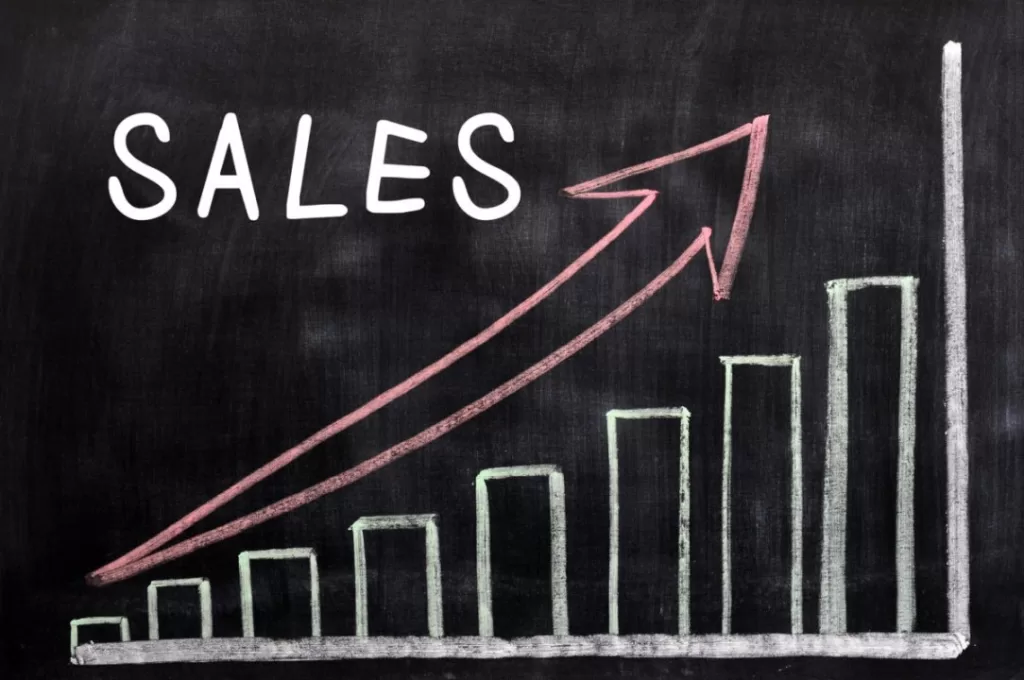
Do I need a business license to sell on Amazon?
Amazon does not require a business license from its sellers. However, local and state laws might demand a business license.
International Sellers
For non-U.S. sellers, the requirements can vary significantly depending on the country in question. It’s important to do thorough research about the local business regulations of your country and possibly take legal advice. Some countries may require sellers to have a business license before they can legally make online sales.
How can I stay updated with Amazon's policies and guidelines? [SUBSCRIBE]
Staying updated with Amazon is paramount as the rules, the algorithm and the marketplace frequently change. My suggestion. Click subscribe to get critical updates and insights, as well as the latest strategies and techniques to boost your Amazon journey in 2024.
What are the shipping options available for Amazon sellers?
As an Amazon seller, you have to consider and select the best shipping option that aligns with your business model. There are three major routes you can take:
Fulfillment by Merchant (FBM)
If you opt for Fulfillment by Merchant, you will be in full control of your inventory and shipping. This means you’ll store your products, pack orders, label them for shipment, and ship them to your customers on your own. While this might sound like a lot of work, it can be beneficial if you want complete control over the packing and shipping process, and if you have resources to handle end-to-end fulfillment in-house.
I have a video that goes into depth on how to set up an FBM listing in under 7 minutes. I will put it in the cards.
Pros and Cons of Fulfillment by Merchant
Pros of Fulfillment by Merchant
Selling as a Fulfillment by Merchant (FBM), or merchant-fulfilled, can provide certain advantages. Let’s discuss some of these:
- More control over inventory: In FBM, you retain control over your inventory, packing, and shipping. It allows for personal touches such as branded packaging, freebies, or thank-you notes that can create memorable customer experiences.
- No FBA fees: FBM sellers don’t have to pay Amazon’s FBA fees. This can significantly reduce cost, especially for low-margin or slow-selling products.
- Fast listing: Products listed by FBM sellers can go live almost immediately, contrasting the wait that FBA sellers may encounter with Amazon receiving and preparing their inventory.
- Less likelihood of stockouts: By overseeing your inventory, you can manage it more accurately and minimize stockouts, which can harm your seller rating.
Cons of Fulfillment by Merchant
However, FBM is not without its downsides. Here are some to consider:
- Time-consuming: Handling your packing, shipping, and customer service can be time-intensive, especially as your order volume grows.
- Increased responsibility: Dealing with customer returns, refunds, and complaints directly adds to your responsibilities and stress levels.
- Warehouse and logistical requirements: You need to invest in storage, packing materials, and shipping infrastructure. You also have to manage logistics effectively to ensure timely delivery.
- Difficult to win the Buy Box: FBA sellers are often prioritized for the Buy Box. Despite having competitive pricing, FBM sellers may find it challenging to win the Buy Box.
Despite these challenges, many merchants find FBM a viable solution. Understanding your business model, resources, and capabilities can help you assess whether FBM is the right choice for you.
Fulfillment by Amazon (FBA)
With Fulfillment by Amazon, Amazon takes responsibility for storing, packing, and shipping your products. You simply need to send your products to Amazon’s fulfillment centers. When a customer places an order, Amazon takes care of everything. This model greatly simplifies your logistics and offers benefits like automatic eligibility for Amazon Prime. However, going this route requires understanding and factoring in certain costs such as Amazon’s fulfillment fees and storage fees.
I have a video that discusses FBA in detail, I will put it in the card.
But understand there are…
Pros and Cons of Fulfillment by Amazon
Pros of Fulfillment by Amazon (FBA)
Amazon’s FBA service is an attractive option for many sellers. :
- Convenience: Amazon takes care of storage, packing, and shipping of your products, allowing you to focus on other aspects of your business.
- Customer Trust: Amazon owns the reputation for having the fastest reliable delivery and the best customer service.
- Prime Eligibility: FBA products automatically qualify for Amazon Prime, which gives your prod increased visibility and sales.
- Global Reach: With FBA, your products can be stored and shipped internationally, giving you access to a global audience.
- Customer Service: Amazon handles customer service and return management for FBA products, saving you time and effort.
Cons of Fulfillment by Amazon (FBA)
Despite its advantages, FBA also has some drawbacks you should consider:
- Fees: FBA can be costly. Fees include storage costs and fulfillment fees and can vary depending on the size and weight of your items.
- Inventory Control: While Amazon handles your inventory, you have less control over inventory management and may face issues with misplaced or damaged items.
- Product Preparation: You’ll need to follow Amazon’s specific product prep requirements for FBA items, which can be detailed and time-consuming.
- Competitive Pricing: With the added FBA fees, maintaining competitive pricing can sometimes be a challenge.
- Potential for Returns: With Amazon handling returns, you may experience higher return rates, which could affect your seller rating.
In conclusion, choosing the right fulfillment method depends on your resources and business model. Both FBA and FBM have their pros and cons, and it’s up to you to choose the one that fits your needs best.
Seller Fulfilled Prime (SFP)
An exciting new option by Amazon allows you to deliver directly to Prime customers in the same way as Fulfillment by Merchant, but you get to enjoy the Prime badge’s benefits. This is called Seller is Fulfilled Prime, and it allows you to manage your own inventory, packaging, and shipping, but with the promise of delivering to customers with Prime’s two-day delivery. You can keep control over inventory and avoid Amazon’s inventory fees, but you must adhere to Amazon’s strict delivery and customer service requirements to maintain Prime eligibility for your products.
When choosing your shipping method, consider the size and weight of your items, your capacity to fulfill orders, your budget, and the preferences of your target customers. Each option has its own advantages and trade-offs, so it’s important to select one that complements your overall sales strategy.
What is FBA (Fulfillment by Amazon) and how does it work?
If you find yourself approaching the long-term storage fee timeline with a lot of inventory still unsold, consider reducing the price to stimulate sales or removing the items from Amazon’s warehouse.
Keeping a close eye on your Inventory Performance Index (IPI) is another way to manage your inventory effectively and potentially avoid these fees. Amazon offers various tools to help you track and improve your IPI as well.
Take the Next Step Toward Unlocking The Power Of Amazon
If you’re looking to get more money from your Amazon efforts, hiring an expert is your best bet. An Amazon Account Management Agency will work with you on so much more than just XXX.
Daily management covers optimization of your ad campaigns, decreasing your advertising cost of sales (ACoS), and boost Sales Conversions, all while taking advantage of Amazon’s highly-effective Enhanced Marketing to grow Organic Attraction.
In other words, if you sell on Amazon (or want to) you can’t afford to not be leveraging experienced Account managers to your benefit.
ECOM OPTIMIZATION Amazon Account Management can help you to build an effective strategy that aligns with your unique brand needs.
Using a hands-on, human-led approach, we’ll help you get more from your Amazon sales channel, so you can enjoy more growth for your business in less time.
Ecom Optimization Amazon Account Management is here to Help
Ecom Optimization is a full-service Amazon Account Management Agency. Our team consists of specialists in all areas of Amazon optimization and management.
When you look at the many ways that Ecom Optimization Account Management can help you grow your brand on Amazon, you’ll see why selling on Amazon becomes headache-free with Ecom Optimization:


